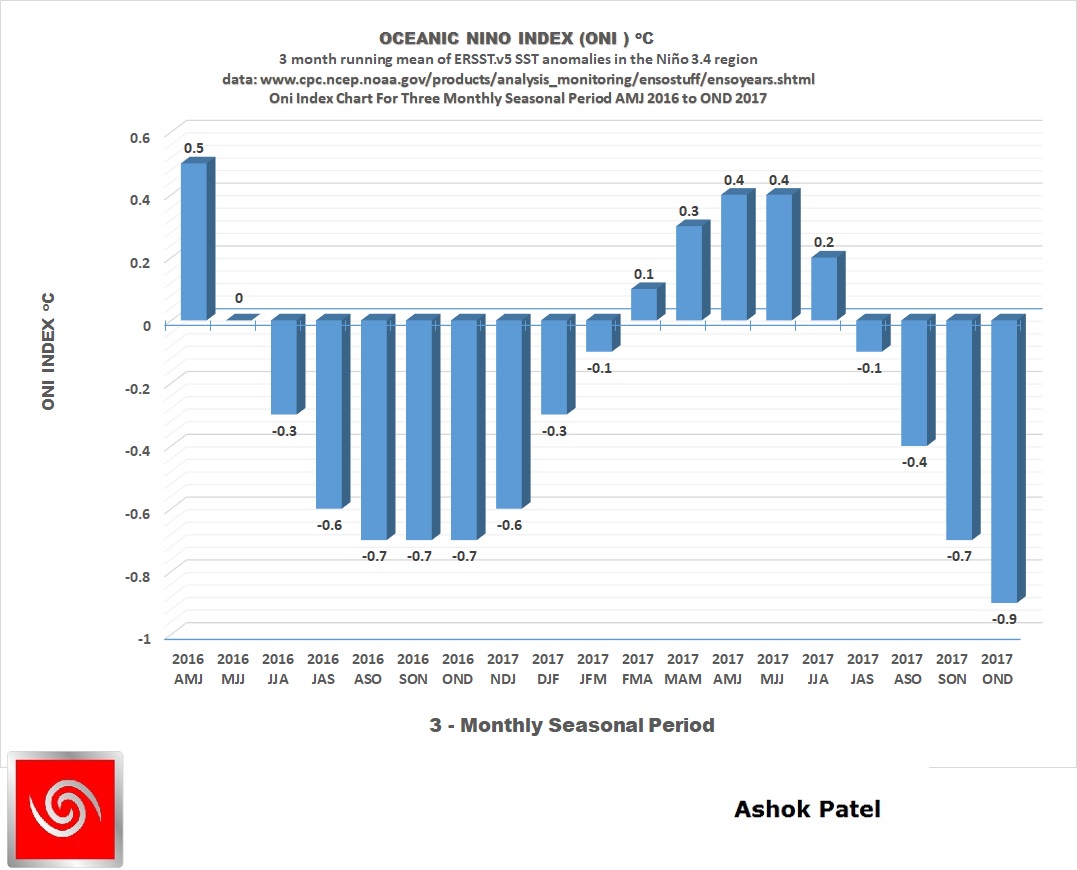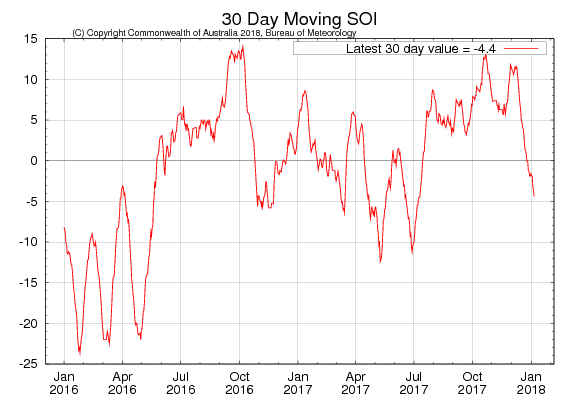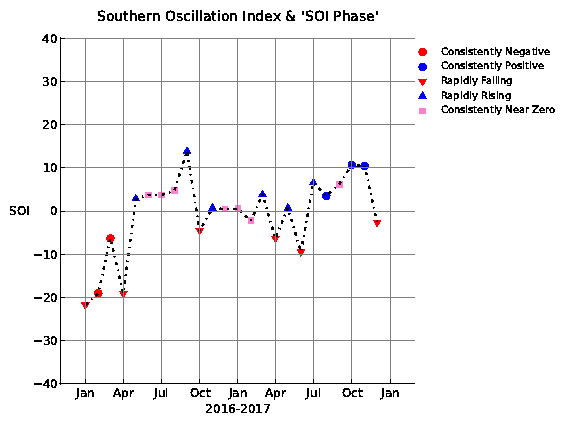ENSO Status on 7th January 2018
The ONI is based on SST departures from average in the Niño 3.4 region, and is a principal measure for monitoring, assessing, and predicting ENSO. Defined as the three-month running-mean SST departures in the Niño 3.4 region. Departures were based on a set of improved homogeneous historical SST analyses (Extended Reconstructed SST – ERSST.v4) and have now been updated to further improved homogeneous historical SST analyses (Extended Reconstructed SST – ERSST.v5). Explanation about ERSST.v5 is given here.
The SST reconstruction methodology is described in Huang et al., 2015, J. Climate, vol. 28, 911-930.
CPC uses current Climatology based on 1986-2015 which has been changed late last year from base years 1981-2010. Explanation about Climatology base years change is given here.
NOAA Operational Definitions for El Niño and La Niña, El Niño: characterized by a positive ONI greater than or equal to +0.5ºC. La Niña: characterized by a negative ONI less than or equal to -0.5ºC. By historical standards, to be classified as a full-fledged El Niño or La Niña episode, these thresholds must be exceeded for a period of at least 5 consecutive overlapping 3-month seasons.
CPC considers El Niño or La Niña conditions to occur when the monthly Niño3.4 OISST departures meet or exceed +/- 0.5ºC along with consistent atmospheric features. These anomalies must also be forecast to persist for 3 consecutive months.
Short lived La Nina ended with last 3-monthly season as NDJ 2017. Subsequently, Enso neutral conditions have prevailed thereafter.
Last five ONI Index are JJA 2017 +0.2ºC, JAS 2017 -0.1ºC, ASO -0.4ºC, SON -0.7ºC and OND -0.9ºC. Only two 3-monthly seasonal ONI Index are in the La Nina zone and hence the Nino 3.4 Region of Pacific Ocean continues to remain officially in ENSO Neutral zone, though leaning towards potential La Nina.
Latest Oceanic Nino Index (ONI) Graph Showing Enso Neutral Event For Last Three 3- Monthly Seasons Ending December 2017
The Table below shows the monthly SST of Nino3.4 Region and the Climate adjusted normal SST and SST anomaly for last two years. Climate Base 1986-2015. ERSST.v5
Period Nino3.4 ClimAdjust YR MON Temp.ºC Temp.ºC ANOM ºC 2016 1 29.11 26.45 2.66 2016 2 29.00 26.66 2.34 2016 3 28.90 27.21 1.70 2016 4 28.73 27.73 0.99 2016 5 28.24 27.85 0.39 2016 6 27.70 27.65 0.05 2016 7 26.82 27.26 -0.44 2016 8 26.28 26.91 -0.63 2016 9 26.15 26.80 -0.65 2016 10 25.98 26.75 -0.78 2016 11 25.95 26.75 -0.80 2016 12 26.10 26.65 -0.55 2017 1 26.12 26.45 -0.33 2017 2 26.68 26.66 0.02 2017 3 27.33 27.21 0.12 2017 4 28.04 27.73 0.30 2017 5 28.30 27.85 0.45 2017 6 28.06 27.65 0.41 2017 7 27.54 27.26 0.28 2017 8 26.70 26.91 -0.21 2017 9 26.29 26.80 -0.51 2017 10 26.15 26.75 -0.60 2017 11 25.74 26.75 -1.01 2017 12 25.62 26.65 -1.03
CPC considers El Niño or La Niña conditions to occur when the monthly Niño3.4 OISST departures meet or exceed +/- 0.5°C along with consistent atmospheric features. These anomalies must also be forecast to persist for 3 consecutive months.
Southern Oscillation Index
As per BOM, Australia:
The 30-day Southern Oscillation Index (SOI) at the end of 2017 was -1.9 and is again in neutral zone. Latest 30-day SOI Index on January 6th was -4.4 which is also in the neutral zone. SOI has swung widely in the last two months.
Sustained positive values of the SOI above +7 typically indicate La Niña while sustained negative values below −7 typically indicate El Niño. Values between about +7 and −7 generally indicate neutral conditions.
SOI Monthly graph up to December 2017 as per The Long Paddock – Queensland Government.
30 Days average SOI was -2.61 at the end of December 2017 and -4.83 on 6th January 2018 as per The Long Paddock – Queensland Government and has entered negative zone again after many months in positive zone though in enso neutral area.
Summary by: Climate Prediction Center / NCEP Dated 2nd January 2018
ENSO Alert System Status: La Niña Advisory
ENSO-Neutral conditions are present.*
Equatorial sea surface temperatures (SSTs) are below average across the central and eastern Pacific Ocean.
La Niña is likely (exceeding ~80%) through the Northern Hemisphere winter 2017-18, with a transition to ENSO-neutral most likely during the mid-to-late Spring.*
* Note: These statements are updated once a month (2nd Thursday of each month) in association with the ENSO Diagnostics Discussion, which can be found by clicking here
As per BOM -Australia 3rd January 2018
ENSO outlooks
International climate models surveyed by the Bureau indicate that some further cooling of the equatorial Pacific sea surface temperatures is expected over the remainder of the southern summer. Five of the eight models remain within La Niña thresholds during March 2018. However, only one out of eight international climate models remain at La Niña levels by the end of autumn (May). In order for 2017-18 to be considered an event, La Niña conditions need to persist for at least three months.
The Bureau’s model POAMA suggests that sea surface temperatures in the equatorial Pacific will remain within La Niña thresholds throughout summer but begin warming back to borderline neutral levels during autumn.
Ashok Patel’s Final Note:
Using NOAA Criteria A Full Fledged La Nina Only Possible by End Of March 2018 .
The current SST December 2017 of Nino 3.4 region is at -1.03°C and only the last two ONI Index have La Nina thresh hold as SON 2017 at -0.7°C and OND 2017 at -0.9°C and so yet Enso Neutral zone prevails. Hence, next three consecutive 3-monthly seasons namely NDJ 2018, DJF 2018 and JFM 2018 should manage to remain equal to or below -0.5°C, for a Full fledged La Nina to be qualified as per NOAA criteria which translates to earliest at the end of March 2018.
અશોક પટેલ ની નોંધ :
હાલ ન્યુટ્ર્લ કન્ડિશન છે – NOAA માપદંડ મુજબ વિધિવત La Nina ફક્ત 2018 માર્ચ આખર સુધી મા શક્ય.
ઓસ્ટ્રેલિયા ની BOM સંસ્થા મુજબ હાલ નબળું La Nina પરિસ્થિતિ છે. જયારે NOAA મુજબ La Nina એડવાયઝરી છે. હાલ ના અંદાજ મુજબ ENSO ન્યુટ્રલ પરિસ્થિતિ છે અને વિધિવત La Nina ની સ્થિતિ માર્ચ 2018 આખર પહેલા શક્ય નથી (NOAA, U.S. ના માપ દંડ મુજબ ); કારણ કે વિધિવત La Nina ડિક્લેર કરવા માટે ના સળંગ 5 ત્રિમાસિક સીઝન La Nina માપ દંડ પ્રમાણે હોવા જોઈએ જે પૈકી હાલ 2 ત્રિમાસિક સીઝન La Nina માપદંડ પ્રમાણે છે. માટે ઓછા માં ઓછા હજુ 3 ત્રિમાસિક સીઝન માં ONI ઈન્ડેક્સ -0.5°C અથવા નીચે રહેવું જોઈએ.
All earlier updates are listed below:
Click here for Update “ENSO Neutral Conditions Prevails With JAS 2017 ONI Index At -0.2ºC”
Click here for Update “Theoretically El Nino Not Possible During 2017”
Click here for Update “Theoretically El Nino Not Possible During The Indian Southwest Monsoon 2017”
Click here for Update “Full Fledged El Nino Not Possible During The Indian Southwest Monsoon 2017”
Click here for Update “ENSO Neutral Conditions At End Of February 2017”
Click here for Update “2016/17 Qualifies As A La Nina Event”
Click here for Update “Enso Neutral Conditions At End Of October 2016”
Click here for Update “Full Fledged La Nina Not Possible During 2016”
Click here for Update “Demise Of El Nino Brings ENSO Neutral Conditions At End Of July 2016”
Click here for Update “Moderate El Nino Persists Till End Of May 2016”
Click here for Update “Strong El Nino Persists Till April 2016”
Click here for Update “NOAA ERSST.v4 & ERSST.v3b & Effects On ENSO Events”
Click here for Update “Yet A Weak El Nino – 6th June 2105”
Click here for Update “El Nino Update – 5th May 2015”
Click here for Update “Weak El Nino Develops March 2015”
Click here for Update “El Nino Status – 6th March 2015”
Click here for Update “El Nino Status – 7th February 2015”
Click here for Update “El Nino Status – 6th January 2015”
Click here for Update “El Nino Status 6th November 2014”


